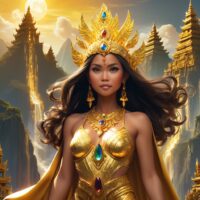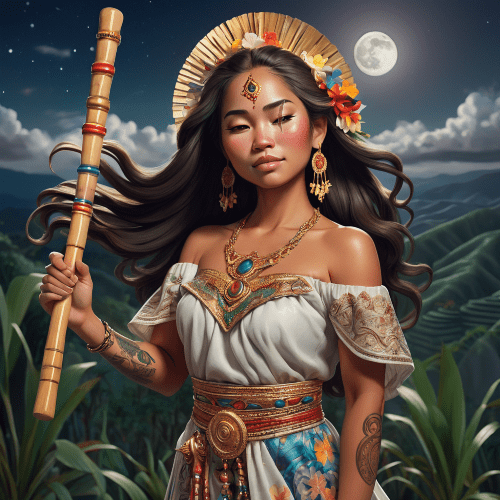Burigadang Pada Sinaklang Bulawan : Goddess of Greed
Listen
At a glance
| Description | |
|---|---|
| Origin | Philippine Mythology |
| Classification | Gods |
| Family Members | Nagmalitong Yawa Sinagmaling, Saragnayan (Siblings) |
| Region | Philippines |
| Associated With | Greed, Wealth |
Burigadang Pada Sinaklang Bulawan
Introduction
Burigadang Pada Sinaklang Bulawan stands as a captivating figure in the mythological traditions of the Visayan people of the Philippines. Known as the goddess of greed, she is both admired and feared. Her name, often translated as “Coveted Gold” or “Desired Precious Gold,” reflects not only her connection to earthly treasures but also her embodiment of the deeper, sometimes darker, impulses of human desire. Revered in the epic Hinilawod, her myth is a reflection of how pre-colonial societies viewed wealth, power, and the balance of moral restraint.
Physical Traits
Burigadang Pada Sinaklang Bulawan is characterized by a radiant beauty that mirrors her association with gold and splendor. Her golden-tinted skin appears to have been kissed by the sun, and her body is adorned with precious stones and shimmering fabrics that signify her connection to the earth’s riches. Myths portray her as so dazzling that her presence could enchant even the gods. This divine allure isn’t simply about beauty but symbolizes the irresistible nature of wealth and the pull of desire that few can resist. Her aura, steeped in opulence, reflects the dangerous seduction of materialism.
Family
This powerful goddess belongs to a lineage of equally compelling divine beings. In the Hinilawod epic, she is the wife of Humadapnon, one of the epic’s three heroic brothers. Her family tree includes several major deities and elemental beings. Her sisters—Nagmalitong Yawa Sinagmaling Diwata and Lubay Lubyok Mahanginun si Mahuyokhuyokan—are goddesses of lust and the night breeze, respectively. Their shared ancestry with Maklium sa T’wan, a primordial earth deity, situates them firmly within a pantheon that oversees both the natural world and human emotions. This connection to elemental forces enriches her mythos, tying her greed-based power to the broader fabric of life, nature, and temptation.
Other names
While most commonly known by her full title, variations and epithets like “Golden Deity” or “The Goddess of Greed” are used in both oral tradition and modern reinterpretations. Her name alone encapsulates her mythological domain, making it rare for her to be called anything else. The grandeur of “Burigadang Pada Sinaklang Bulawan” is intentionally weighty, evoking not just her divinity but the heavy cost of desire unchecked. Some traditions expand her role, associating her not just with greed, but also with vengeance and justice, especially against those who exploit others for personal gain.
Powers and Abilities
As a goddess closely tied to wealth and the raw emotions it provokes, Burigadang Pada Sinaklang Bulawan wields formidable powers. She governs precious metals and gems, and it is said that her very touch can turn objects into gold. This makes her a symbolic patron for miners, metalsmiths, and jewelers. But she is no benevolent giver—her gift of gold comes with a warning. She can manipulate human emotion, intensifying greed and envy with just a whisper or breath. In her stories, she often appears as both a seductress and a punisher. In Hinilawod, she tests suitors through their greed, allowing them to destroy each other. Her ultimate submission to Humadapnon comes only after he proves worthy by overcoming these trials.
Her connection to the earth is also expressed through her association with dwendes, small supernatural beings who dwell in the land and are said to protect its riches. She is sometimes said to live in a golden home guarded by these spirits, whose wisdom in mining and metallurgy mirrors her own dominion. Her powers even extend to protection and punishment. In pre-colonial societies, travelers would carry charms with her image to guard against theft, relying on her wrath to curse robbers. This duality—of wealth and punishment—places her in a unique space among the diwatas, as both a provider and enforcer of moral law.
Modern Day Influence
The legacy of Burigadang Pada Sinaklang Bulawan has persisted, even under centuries of colonial influence that sought to erase native deities. Spanish colonizers actively discouraged the worship of pre-Christian gods, destroying many of the altars and suppressing their stories. Yet she lives on in folk memory, believed by many to still roam the earth in spirit form, delivering justice to those who hoard or exploit wealth at the expense of others.
Her mythology has found new life in modern Filipino culture. In 2013, she was portrayed by Katrina Halili in the historical-fantasy series Indio, reintroduced to a contemporary audience as a goddess of vengeance and desire. This dramatization emphasized her fierce personality and moral depth, especially in the storyline where she seeks justice for her brother Paiburong’s death.
Folklore continues to paint vivid stories of her wrath. In one tale, she punishes a vain young woman named Angga by transforming her into a golden-hooved creature after she arrogantly claimed to surpass any goddess in beauty. In another, she metes out a terrifying lesson to her lazy dwarven maidservants by turning them into fungi and termite hills, warning future generations about the price of disrespect.
She even appears in cautionary tales that blur moral and mythic boundaries—such as a beauty contest where she is tricked into performing in a dark cave, thus hiding her luminous form. Her rage from the deception leads her to stomp her rival into the earth, transforming her into the firefly, a creature doomed to shine in isolation. These narratives reflect not just her divine nature, but the rich imagination of a culture that uses myth to explore themes of vanity, justice, and the burden of wealth.
In recent years, she has become a subject of academic and artistic interest. Her name and image feature in creative writing, diaspora storytelling, digital art, and postcolonial feminist discourse. Artists and mythologists explore her symbolism as a critique of modern consumerism and the lasting effects of colonial erasure of indigenous identities. Through workshops, myth-focused podcasts, and mythology-based education, Burigadang Pada Sinaklang Bulawan’s presence has surged back into relevance, not only as a goddess of greed but as an icon of feminine power and cultural reclamation.
Related Images
Source
Clark, J. (2016). Visayan deities in Philippine mythology. The Aswang Project. https://www.aswangproject.com/visayan-deities-in-philippine-mythology/
Ibarra, J. (2019, December 3). Pinay zodiac: Sagittarius/Burigadang Pada Sinaklang Bulawan. Hella Pinay. https://www.hellapinay.com/article/2019/12/3/pinay-zodiac-sagittarius
Jocano, F. L. (2005). Outline of Philippine mythology. Punlad Research House. (Book, physical source – no official online version available)
Demetrio, F. R., Cordero-Fernando, G., & Zialcita, F. N. (1991). The Soul Book. GCF Books. (Book, physical source – no official online version available)
Monteclaro, P. A. (1907). Maragtas. University of Michigan. https://catalog.hathitrust.org/Record/008698267
Lucero, R., & Pototanon, R. M. (2018). Capiznon. In Our islands, our people: The histories and cultures of the Filipino nation. https://www.panitikan.com.ph/content/capiznon
Frequently Asked Questions
What is lorem Ipsum?
I am text block. Click edit button to change this text. Lorem ipsum dolor sit amet, consectetur adipiscing elit. Ut elit tellus, luctus nec ullamcorper mattis, pulvinar dapibus leo.
What is lorem Ipsum?
I am text block. Click edit button to change this text. Lorem ipsum dolor sit amet, consectetur adipiscing elit. Ut elit tellus, luctus nec ullamcorper mattis, pulvinar dapibus leo.
What is lorem Ipsum?
I am text block. Click edit button to change this text. Lorem ipsum dolor sit amet, consectetur adipiscing elit. Ut elit tellus, luctus nec ullamcorper mattis, pulvinar dapibus leo.
What is lorem Ipsum?
I am text block. Click edit button to change this text. Lorem ipsum dolor sit amet, consectetur adipiscing elit. Ut elit tellus, luctus nec ullamcorper mattis, pulvinar dapibus leo.
What is lorem Ipsum?
I am text block. Click edit button to change this text. Lorem ipsum dolor sit amet, consectetur adipiscing elit. Ut elit tellus, luctus nec ullamcorper mattis, pulvinar dapibus leo.











